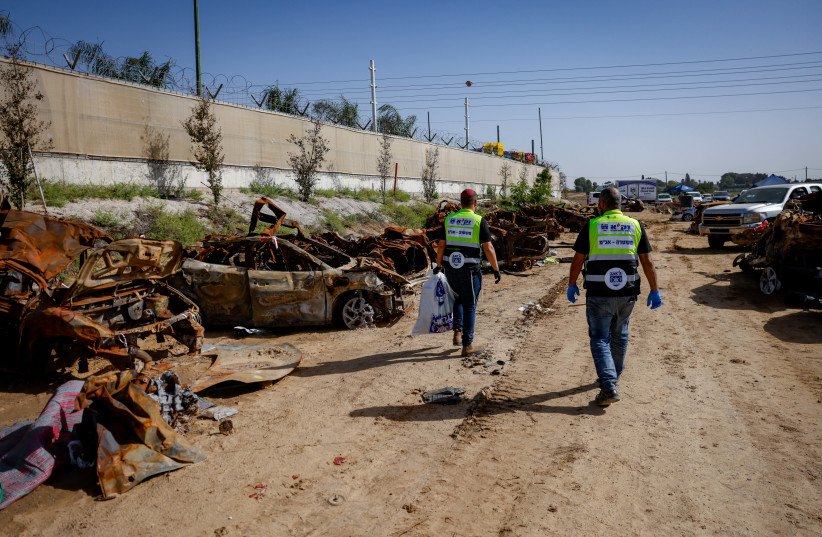Evidence on the mass rape of women, three months after the October 7 Massacre, is still being collected. On Sunday, The Telegraph reported that the full extent of Hamas’s sex crimes may never be known – for a variety of reasons.
In an interview with Haim Otmazgin, a ZAKA volunteer and first responder, The Telegraph details barriers to uncovering the evidence of mass rape and sexual abuse on October 7.
Otmazgin said he was not looking for evidence of sexual abuse when he joined the mission to recover the dead, murdered, and mutilated victims of the Hamas attack, but he found it when he entered Be’eri, one of the worst hit Kibbutzim on the border of Gaza.
While Otmazgin was collecting the bodies in the field, Shari Mendes, stationed on an IDF base, was one of those receiving the corpses as they came in.

While Otmazgin was collecting the bodies in the field, the IDF base was receiving the corpses. Shari Mendes was one of the individuals receiving the bodies.
“Many young women arrived in bloody shredded rags or just in underwear, and their underwear was often very bloody," Mendes said. "Our commander saw several female soldiers shot in the crotch or the breast. There seemed to be systematic genital mutilation of a group of victims.” Forensic reviews of video footage, interviews, and these images illustrate a pattern of sexual violence perpetrated against women in Hamas’s attacks.
First responders overwhelmed, much evidence not collected
One of the barriers outlined in this report is that only some of the evidence Otmazgin collected that day is reaching the public domain now, partially due to the panicked initial response from authorities and volunteers. Both Otmazgin and Mendes told The Telegraph they were overwhelmed on the day of the attacks and that their work was focused on finding survivors or preparing bodies, and that everyone was in a hurry at the morgue to release bodies to the families for burial. They were not looking for clues about exactly what happened to them, so much evidence escaped collection.
An investigation by Yediot Ahronot at the beginning of December detailed the failures of Israeli authorities to preserve forensic evidence in the aftermath of the Hamas attack. Unnamed officials described a pattern in which immediate identification was prioritized over evidence collection. Jewish law requires burial within 24 hours after death.
Otmazgin did admit that he and his colleagues had missed some of the evidence because he had covered the bodies or adjusted their clothing “out of respect” when he came across them.
Another obstacle is that most survivors are not speaking out. Prof. Ruth Halperin-Haddari, an Israeli legal scholar who served 12 years on the UN Committee on the Elimination of Discrimination against Women, estimates that there are at least 10 survivors who were subjected to sexual violence. The Telegraph reported that she said that most victims were murdered by Hamas attackers immediately after the rapes.
It often takes years before assaults are reported, and victims could be unwilling to speak out because of a “very heavy cost” for the families. “It’s a small country, everyone knows everybody,” Halperin-Kaddari said.
Police have launched an official investigation into reports of sexual violence on October 7.
Some of the freed hostages are also survivors of sexual assault, explained Renana Eitan, the chairman of the psychiatry department at Tel Aviv’s Sourasky Medical Center. Dr. Eitan told The Telegraph that doctors specifically asked the patients not to speak publicly about their cases out of fear that they would be retraumatized.
However, she said the hospital is cooperating with the police investigation. The Telegraph did speak to a source familiar with the investigation and said that there are growing tensions between Israeli hospitals treating former hostages and police pushing them to provide details of suspected rape cases. Hospitals dismissed the calls, arguing doctor-patient confidentiality.
